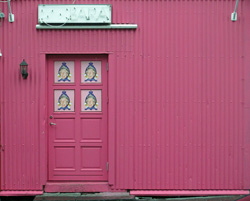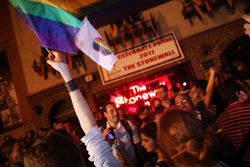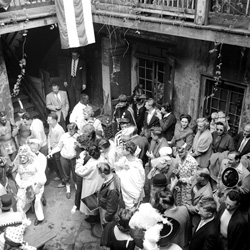The Gay Bar
Is it dying?
This series is also available as an e-book for your Kindle. Download it now.
When the New York State Senate voted 33-29 to approve same-sex marriage on Friday, June 24, gay and lesbian New Yorkers—and some straight supporters—knew the perfect place to celebrate: They headed to the Stonewall Inn, the gay bar where, 42 years earlier, the modern gay rights movement had been born. Amid the glorious chaos of fire-eaters, drag queens, and spontaneous proposals, older gay couples walked hand-in-hand admiring the scene. The jubilation at Stonewall and on the surrounding streets was a stirring celebration of progress. But I can't help wondering whether, as gay rights move forward, the gay bar—the place where it all began—may get left behind.
I rarely go to gay bars anymore. I've been in a happy relationship for 14 years with someone who rarely drinks. Bars are loud, they get going too late, and they're packed with kids half my age. They make me feel old. But I feel bad about abandoning them. I still remember the terrifying, giddy excitement of my first forays into gay pubs and clubs, the thrill of discovering other lesbians and gay men in all their beautiful, dreary, fabulous, sleazy variety. I learned how to dance to 15-minute techno remixes under spinning disco balls, how to appreciate tacky drag shows and to show proper respect for the heroines of the pool table. Gay bars are my cultural patrimony and my political heritage.
Once upon a time—back in the dark days of the late 20th century—gay bars were the only venues where gay people could let down their defenses. Now, at least in urban centers, gay men and lesbians feel safe in scads of straight restaurants and bars. But when new options open up, what happens to the old segregated institutions? In 2007, Entrepreneur magazine put gay bars on its list of businesses facing extinction, along with record stores and pay phones. And it's not just that gays are hanging out in straight bars; some are eschewing bars altogether and finding partners online or via location-based smartphone apps like Grindr, Qrushr, and Scruff. Between 2005 and 2011, the number of gay and lesbian bars and clubs in gay-travel-guide publisher Damron's database decreased by 12.5 percent, from 1,605 to 1,405. Could the double whammy of mainstreaming and technology mean that gay bars are doomed?
I'll explore that question later this week. But before we get to the future, it's worth taking a moment to consider the past, and what we would lose if the gay bar went the way of the typewriter. I don't want to get stuck in nostalgie de la boue; I'm very glad to live in an era where I don't have to pretend that my partner is my roommate or make a marriage of convenience. I'm relieved that for my generation, gay bars are but one dish on a vast menu of leisure-time options. But I'd feel their passing far more fiercely than the loss of the neighborhood video store. Without the gay bar, gay culture and gay rights might not exist.
After all, gay liberation is the only civil rights movement that began in a bar. The Pride celebrations that take over the streets of America's gay ghettos every June commemorate the anniversary of the Stonewall uprising of June 28, 1969—42 years ago this week—when the patrons of a Mafia-run gay bar in Greenwich Village protested against a police raid. Stonewall was not the first time that gay people had fought back against police harassment, nor, as we will see, was it the first time that bar raids sparked protests. Bars played this political role because bars were where gay people gathered.
The gay bar has always been a refuge for homosexuals, a place where, as Edmund White once put it, gays "can feed and mate relatively free of predators." Historically, gay bars were a haven from the strictures of the closet, a safe space where patrons could take off the masks they wore while passing for straight. Many lesbians saw them as the one place they could wear the clothes they felt comfortable in rather than the costumes they were forced to wear in the wider world. They were a place to meet, to socialize, to find friends and potential partners. In a way, they were our church, with sermons delivered by disco divas.

Unlike other minorities, queers don't learn about our heritage from our birth families. Bars are our Hebrew school, our CCD, our cotillion. As activist pioneer Dick Leitsch wrote in Gay magazine in September 1970: "Gay bars … teach and enforce the ethics and rules of gay life and pass on traditions and gay culture. One learns how to make out, to use gay slang." Bars are a place to find fellowship. One friend told me that in his early 20s, "I formed a sort of bar family—people I talked with, drank with, occasionally slept with, and generally escaped regular life with. As potentially self-destructive as getting drunk four nights a week and sleeping with far too many people was, I felt that I was among my people—in a way that I had never done before."
Although bars are public places, they offer a certain measure of privacy. For a lot of young people, even today, the gay bar is a much-needed way station on the path to coming out. Brett Thomas, who owns Studio 13, Iowa City's only gay bar, described a pattern he sees every year in the college town: "A closeted kid is not going to go to an LGBT youth rally at the university. What he's going to do is come in during a drag show, sit in a dark corner after pacing back and forth in front of the bar nine times." A gay bar can offer a lonely, curious young person entrée to a whole new world.
In his much-cited 1989 book The Great Good Place, Ray Oldenburg celebrated so-called third places, which he defined as "the core settings of informal public life." Not the home, not the office, the third place is a space like the Viennese coffee shop, the French cafe, or the British pub, a venue for "regular, voluntary, informal, and happily anticipated gatherings of individuals beyond the realms of home and work." You've probably heard Starbucks CEO Howard Schultz name-check this theory as a justification for his coffee empire. But it also helps explain why gay bars have been so vital to gay culture. Oldenburg valued these spots because the ease of association fosters community life and satisfies individuals' need for communion. This urge to find community is especially strong for gay people, who may be rejected by their families or shunned by their co-workers. The third place is even more precious when places one and two are hotbeds of homophobia.
So what do these community-fostering safe spaces feel like? The average gay bar is not much different from the average straight bar—they just have more rainbow bunting and one underutilized bathroom. In a gay men's bar, the jukebox might offer more female singers with no last names and a few more beats per minute. If it's a lesbian bar, there's a good chance you'll find a proliferation of black-and-white photographs of strong-jawed women. Thanks to the drag tradition, gay bars are more likely than any other kind of tavern to feature a stage, no matter how rudimentary, and patrons' pockets are more prone to be stuffed with dollar bills so they can tip the queens.
Gay bars, like straight bars, also come in many flavors—chic, dance-oriented, dive. The bartender sets the tone for a venue, modeling the kind of look that prevails in the place. In New York's East Village, for example, bartenders generally sport tattoos and shaved heads; in the West Village, they're skinny and hairless; in Chelsea, they're toned and muscular. Most of the time, even in the depths of winter, gay-bar tenders wear tank tops, and they're more likely to have been hired for their biceps than their mixology skills. In dive bars, though, there's less exposed flesh on both sides of the bar—T-shirts or even long sleeves are de rigueur for the servers. It can be particularly tricky to distinguish the straight dive bar from its gay equivalent—the most obvious differentiator is that in a homosexual establishment, new arrivals are more likely to be greeted with a kiss. There's more literature in gay bars—bar rags, Pride guides, flyers for fundraisers, maps of the gay scene in other towns—even if no one is reading.
The big difference, of course, is the way the patrons pair off. It's not necessarily true that everyone in the place is a Kinsey 6, but they should be cool with being approached by a member of the same sex. A friend told me she patronized gay bars "to make sure the woman I might be hitting on was in fact a fellow lez. If she were straight, she was on my turf, and it was too damn bad—an occupational hazard of hanging out in a dyke bar." The joy of being able to flirt freely, to dance uninhibitedly, to show affection without fearing for your life is still denied in the larger world. Even today, when same-sex couples can marry in five (soon to be six) states and the District of Columbia, there are few nonsegregated places where two newlywed grooms could celebrate their union with a kiss without attracting threats or worse.
Gay bars have long offered, in ways both fundamental and subtle, something political activist Urvashi Vaid has called "the freedom to be fully gay." Even in New York City, she says, "If you were to go to Staten Island or even parts of the Upper East Side and start making out—in a way that a heterosexual couple wouldn't even think about; I'm talking about kissing, holding hands, snuggling, the sort of things that you see straight people do ordinarily—it would raise eyebrows. It would definitely make people uncomfortable." A young gay man named Bryan reported that when he goes to a straight bar, he even orders differently—he's far less likely to ask for a splash of St-Germain in his gin and tonic, for example—and he finds it harder to relax. In sexually charged straight bars, where people are looking to hook up, Bryan worries that he will get tipsy and "slip up." It's not that he would make a move on a straight guy, but he's concerned that a heterosexual man will misinterpret a gesture or comment and lash out at him. For gay people, Vaid points out, "the ability to be public is still partial and constrained." Gay bars loosen those constraints.
We paid a price for making the gay bar the center of the community. A booze joint isn't always a positive environment. The noise makes conversation difficult, lending outsize importance to physical signifiers, a surefire recipe for shallowness and superficiality. (Homosexual establishments have no monopoly there, of course.) And then there is the alcohol. For all the talk of bars as sanctuaries, they exist to push booze, which can be a devastating force. Martin Duberman's book Stonewall describes the atmosphere at Kooky's, a 1960s lesbian bar in Manhattan: "[Kooky] ran her bar like a tyrannical man, ordering the lesbian patrons around as if they were scum, beneath contempt. She would think nothing of coming up to a woman sitting at the bar, grabbing her glass, and shoving it up to her mouth. 'Drink up, drink up,' she would growl. … Then Kooky would turn to the bartender and bark, 'She's buying another drink.' " And, of course, gay bars aren't always a safe haven: In October 2010 alone, there were two violent attacks on gay men in Greenwich Village bars.
I wish our taverns were more like Spanish bars, with an emphasis on socializing rather than drinking, but I still feel a lingering affection for gay bars' stale-beer smell and their dim-lit charms. It's wonderful to have the run of the city—to roam at will rather than stick to our own streets and safe spaces. But if the gay bar disappears, where will we learn to dance? Where will we realize that we're not alone? Where will we go to feel normal?


